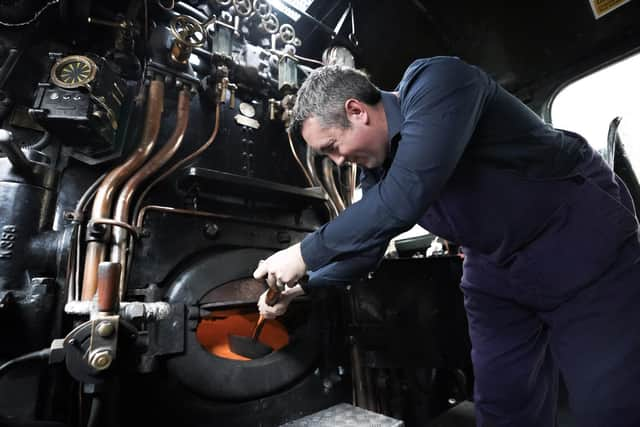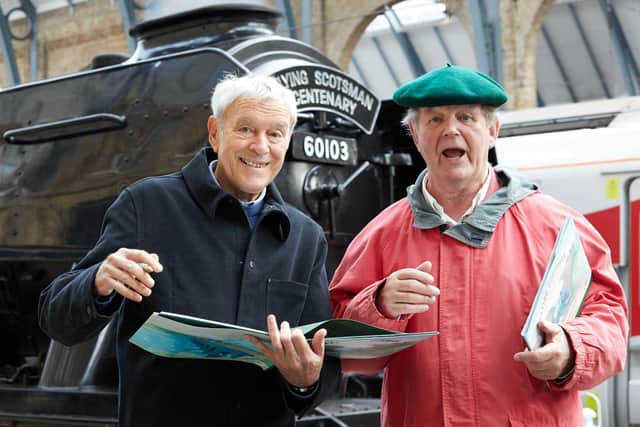Flying Scotsman centenary: Author Michael Morpurgo on coming face to face with world's most famous locomotive
Do you want to get up on the footplate?, he was asked. Of course he did. He had wanted to since being a child, a boy of the generation where steam passenger trains were how many people travelled.
“So I climbed up and there was the coal, the smell of the coal, there was the shovel, there was the driver. And he said the best thing he could possibly say - ‘do you want to pull the whistle?’
Advertisement
Hide AdAdvertisement
Hide Ad"I felt about six or seven and it was wonderful. I pulled the whistle of Flying Scotsman and it sounded all over London and I didn’t want to stop, I was having such fun.”


Morpurgo launched the train’s centenary celebrations in October last year, with a reading to children at London’s King’s Cross Station.
The author and his long-standing illustrator Michael Foreman collaborated with the National Railway Museum in York to release a book celebrating 100 years since the engine entered service on February 24, 1923.
Titled Flying Scotsman and the Best Birthday Ever, the book focuses on young girl Iris as she longs to follow in the footsteps of her father, who is the driver of the famous train.
Advertisement
Hide AdAdvertisement
Hide AdMorpurgo read a true story about the life of a man who had driven steam trains in the 1930s and ideas began to flow. He decided the man would have a daughter and from then on, it was "invention, invention, invention”.


“Once I get into the inventing of it, the history is still there in my head, the pictures of the stations, the smell of the trains, all that was there in the writing,” Morpurgo says.
“The important thing was to have a child central to the story because it is afterall a book for young people. And when you’re writing books for young people, there has to be a Harry Potter, a boy or girl at the heart of the story.”
The tale takes readers on a journey through the golden age of steam travel, paying tribute to the women who kept the railways running during the Second World War.
Advertisement
Hide AdAdvertisement
Hide AdMorpurgo says: “The potential for women to fulfil themselves happened massively after the Second World War, when it was discovered during the war that women were needed to do so many jobs that only men had been doing, including railway work, including driving steam trains…


"The women ran so much that needed to be run at home during the war, as well as dealing with grief and everything else...The war over, they had a new place in life. The world changed…
"I wanted to write a story about that, about the moment when, during the war, [Iris] was up pulling the levers [in the signal box at King’s Cross Station] to direct Flying Scotsman on her way along the railway line up to Edinburgh.”
Little over a week after he started writing, Morpurgo had crafted the tale and sent the words to Foreman, who brought them to life with his artwork.
Advertisement
Hide AdAdvertisement
Hide Ad“We’re so in tune with each other because we’ve done almost 30 books together,” Morpurgo says. “We do know each other really well, we’re almost married for goodness sakes. He gets my stories and I get his illustrations.”
Both men have many personal recollections of travelling by steam train. For Hertfordshire-born Morpurgo, the engines were as synonymous with setting off on childhood holidays as they were with commuting to boarding school.
He’d take them there and back from the school, where he stayed for many weeks at a time, away from his family.
“Saying goodbye to your mum was really hard, and there were lots of tears and lots of homesickness, all standing beside a train,” he recalls. “The train was like a presence in your life.
Advertisement
Hide AdAdvertisement
Hide Ad“The opposite happened when you came home from holidays and everyone was in the carriage all excited and jumping up and down.
"And then you got out and there was your mum and life was alright again, all witnessed by a steam train with the noise all around you…I remember the sound of them, the smell of them, the rhythm of them…
"[Michael and I] are both of the generation where steam trains were how we travelled. We grew up with them, the smell of them and the look of them, stations being full of steam.”
One of Morpurgo’s earliest memories is standing on a railway bridge on a day out with his brother, where they waited with excitement for trains to pass.
Advertisement
Hide AdAdvertisement
Hide Ad“If you stood on the bridge, the trains would come along with their steam coming up and then the steam would come under the bridge and you’d be completely covered in smoke. You’d cough your way through it and it was really fun and then you’d wait for the next one.”
Despite his childhood exploits, Morpurgo, who was awarded a knighthood in 2018 for services to literature and charity, did not get up close to the locomotive until the age of 79. He’d been a lifelong fan when he saw Flying Scotsman at King’s Cross last year.
A century after it started life at Doncaster Works, where the train was built at a cost of £7,944, the engine still draws in excited crowds wherever it goes.
Today the locomotive is owned by the National Railway Museum in York, where it remains synonymous with the golden age of rail travel, renowned as a feat of both design and engineering.
Advertisement
Hide AdAdvertisement
Hide AdA programme of events and activities has been planned to mark its birthday. It’s a privilege to be involved in the celebrations, Morpurgo says, the book offering a chance to share an important part of the country’s rail history with the next generation. It also presents an opportunity to inspire authors and illustrators of the future, he says.
“The most important thing is to get books into the hands of children and what’s really lovely is you never know which book it is that a child is going to pick up and read and think gosh that wass really good.
"It might make them think I want to read more books and they become a reader for life or they might think I’ll make up a story and become a writer or an illustrator. Books can really change the lives of children.”
Designed by Sir Nigel Gresley as the first locomotive of the LNER (London and North Eastern Railway), Flying Scotsman became the first engine to officially reach 100mph in 1934.
Advertisement
Hide AdAdvertisement
Hide AdIt soon captured the hearts of the nation, operating in service until 1963 and later in preservation, with tours of the USA, Canada and Australia.
“It was just extraordinary how much the Flying Scotsman was taken around and celebrated around the world,” Morpurgo says. “It really is the most famous train the world has ever seen. As it was standing there at King’s Cross Station, what should draw up alongside it but a modern train with a pointed nose.
"It was an electric one I think, which is much better in terms of the pollution it’s putting out there, but it really looked sad alongside to the real thing. And to me, when it comes to steam trains, the real thing will always be the Flying Scotsman.”
Flying Scotsman and the Best Birthday Ever by Michael Morpurgo, illustrated by Michael Foreman and published by Thames & Hudson is out now.
The full collection of Foreman’s watercolours for the book are on show in an illustration exhibition running at Danum Gallery, Library and Museum in Doncaster until June 17.
